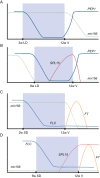Gene regulatory networks controlled by FLOWERING LOCUS C that confer variation in seasonal flowering and life history
- PMID: 32369593
- PMCID: PMC7816851
- DOI: 10.1093/jxb/eraa216
Gene regulatory networks controlled by FLOWERING LOCUS C that confer variation in seasonal flowering and life history
Abstract
Responses to environmental cues synchronize reproduction of higher plants to the changing seasons. The genetic basis of these responses has been intensively studied in the Brassicaceae. The MADS-domain transcription factor FLOWERING LOCUS C (FLC) plays a central role in the regulatory network that controls flowering of Arabidopsis thaliana in response to seasonal cues. FLC blocks flowering until its transcription is stably repressed by extended exposure to low temperatures in autumn or winter and, therefore, FLC activity is assumed to limit flowering to spring. Recent reviews describe the complex epigenetic mechanisms responsible for FLC repression in cold. We focus on the gene regulatory networks controlled by FLC and how they influence floral transition. Genome-wide approaches determined the in vivo target genes of FLC and identified those whose transcription changes during vernalization or in flc mutants. We describe how studying FLC targets such as FLOWERING LOCUS T, SQUAMOSA PROMOTER BINDING PROTEIN-LIKE 15, and TARGET OF FLC AND SVP 1 can explain different flowering behaviours in response to vernalization and other environmental cues, and help define mechanisms by which FLC represses gene transcription. Elucidating the gene regulatory networks controlled by FLC provides access to the developmental and physiological mechanisms that regulate floral transition.
Keywords: FT; SQUAMOSA PROMOTER BINDING PROTEIN-LIKE 15; SUPPRESSOR OF OVEREXPRESSION OF CONSTANS 1; FLOWERING LOCUS C; Floral transition; MADS-domain; vernalization.
© The Author(s) 2020. Published by Oxford University Press on behalf of the Society for Experimental Biology.
Figures


References
-
- Abe M, Kosaka S, Shibuta M, Nagata K, Uemura T, Nakano A, Kaya H. 2019. Transient activity of the florigen complex during the floral transition in Arabidopsis thaliana. Development 146, dev171504. - PubMed
-
- Alon U 2007. Network motifs: theory and experimental approaches. Nature Reviews. Genetics 8, 450–461. - PubMed
-
- Andrés F, Coupland G. 2012. The genetic basis of flowering responses to seasonal cues. Nature Reviews. Genetics 13, 627–639. - PubMed
Publication types
MeSH terms
Substances
LinkOut - more resources
Full Text Sources
Other Literature Sources
Molecular Biology Databases
Research Materials

